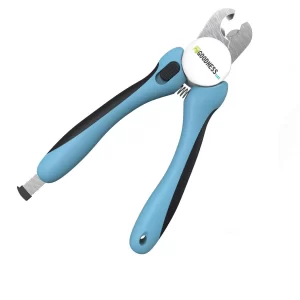The Grooming Tools
More often than not, the first thing that comes to mind when people think about dog grooming tools is the pin brush, or maybe the slicker brush. There are plenty more tools to groom your furry best friend with, however, and they all have a different use.
Here are some of the more common grooming tools.
Rubber Friction Brush.
One of the easiest tools to use, the rubber friction brush is covered with short “bristles” on one side, with a loop to slip your hand through on the other side. This is a good tool to use with short-haired dogs that shed a lot. It helps get rid of loose hair, while basically giving the dog an all-over massage.
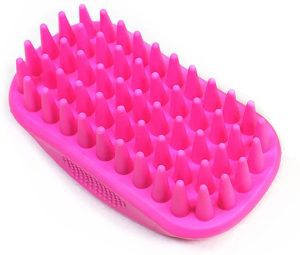
Natural Bristle Brush
Natural bristle brushes for dog grooming are similar to those used on humans. Some will have handles that extend from the base of the bristled head, but others have a handle more centrally placed (such as that pictured here), for easier brushing. Nylon bristles create static in the fur, but the natural bristles do not. Instead, they simply smooth the fur and distribute the natural oils present in your dog’s coat.

Metal Comb
For non-shedding dogs, a metal comb is the best thing for working out tangles. It looks like a human hair comb, but the find on a human comb.
If you are dealing with a tangle in your dog’s coat, it’s best to start working away at the bottom of it, so that you don’t hurt your dog by basically pulling at an entire chunk of fur.
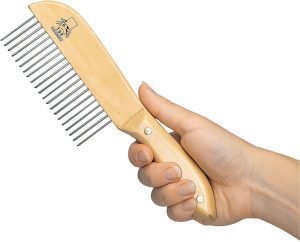
DeShedding Comb
The De-Shedding comb looks a very short, tight comb with a handle that is often at a right angle to the comb’s head. At a closer look, the comb actually has a small blade that is set into the comb itself. This blade, combined with the close-set tines make de-shedding comb a must-have for those of you who have heavy shedders.
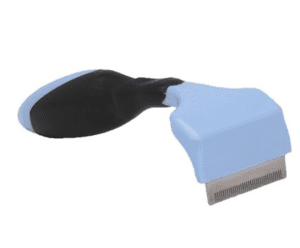
Shedding Blade
A shedding blade is like a an extremely flexible saw, with two serrated edges that are only sharp enough to grab loose fur for removal. The blade is used by bringing the two handles together, so that the blade itself forms a loop, then running it over your dog’s fur. Even though the serrations are not really sharp, it’s important not to apply too much pressure when using this tool.
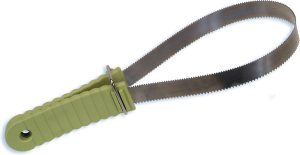
Shedding Rake
The shedding rake basically resembles a very small grass rake, with wide-set tines that are designed to help remove loose undercoat. The tines are metal, so be sure not to apply too much pressure when using this tool.
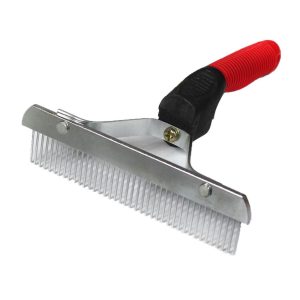
Slicker Brush
The slicker brush is probably the most common grooming tool sold at pet stores. It’s usually comprised of a rectangular head with a bunch of short, curved wires. The brush is not built to handle thicker fur, so it’s most often used on breeds with fine hair.
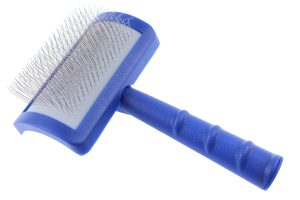
Pin Brush
A pin brush is sort of a hybrid of the bristle brush and the metal comb. It’s used to remove tangles from long and double-coated dogs, as well as wirehaired breeds, and can be basically used interchangeably with the comb.
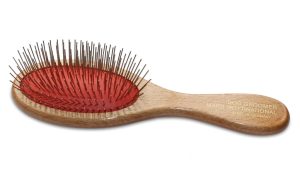
Hound Glove
Hound gloves are sort of a fusion between winter gloves and the rubber friction brush. If you have a short-haired dog, and you tend to be all thumbs with combs and brushes, the Hound Glove may be the tool for you. All you do is slip them over your hands and give your dog a good all-over rub-down. The rubber nubs will help remove the dead hair from your buddy.
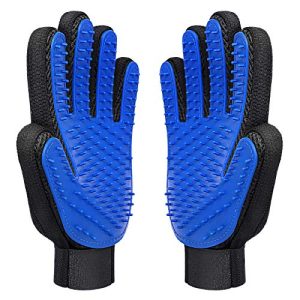
Nail Trimmer
Dogs’ nails aren’t remotely the same as human nails in shape or size, so it stands to reason that their nail clippers are also not the same. While some dogs are OK with having a Dremel or other power tool used on their nails, most dogs prefer a simpler way. A dog nail trimmer looks kind of like a wire cutter, but there is a circular gap in the head where the nail rests and a trimming blade comes up under the nail as you squeeze the handle.
